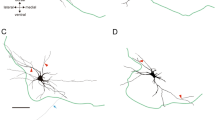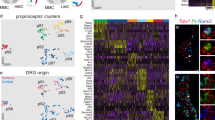Abstract
MOVEMENT and position of each joint of a crab's leg beyond the coxa are signalled by large groups of peripherally located sensory neurones comprising chordotonal organs1,2. In contrast, the basal joint of each leg has a single compound muscle receptor innervated at its proximal end by two large and one small sensory nerve fibres each of which lacks a peripheral cell body arid nucleus3,4. One of the two large fibres, the T fibre, terminates in the tendonous proximal end of the receptor muscle, while the other, the S fibre, sends a large branch to each of the two connective tissue strands on either side of the receptor muscle (Fig. 1). From these branched terminations the fibres retain a nearly constant diameter of 50–60µ, for the 2.5–4 mm (in the posterior legs of crabs with carapaces 30–40 mm wide) to the thoracic ganglion, where their cell bodies are presumed to lie. One or more much finer motor fibres run with the sensory fibres to innervate the receptor muscle. This small muscle lies in parallel with the promoter muscle, which moves the whole leg forwards at the basal (thoracic-coxal) joint. It inserts distally on the promotor tendon.
This is a preview of subscription content, access via your institution
Access options
Subscribe to this journal
Receive 51 print issues and online access
$199.00 per year
only $3.90 per issue
Buy this article
- Purchase on Springer Link
- Instant access to full article PDF
Prices may be subject to local taxes which are calculated during checkout
Similar content being viewed by others
References
Wiersma, C. A. G., and Boettiger, E. G., J. Exp. Biol., 36, 102 (1959).
Bush, B. M. H., Comp. Biochem. Physiol., 14, 185 (1965).
Alexandrowicz, J. S., and Whitear, M., J. Mar. Biol. Ass. UK, 36, 603 (1957).
Whitear, M., Phil. Trans. Roy. Soc., B, 248, 437 (1965).
Gwilliam, G. F., Biol. Bull., 129, 244 (1965).
Millechia, R., Bradbury, J., and Mauro, A., Science, 154, 1199 (1966).
Atwood, H. L., Amer. Zoologist, 7, 527 (1967).
Author information
Authors and Affiliations
Rights and permissions
About this article
Cite this article
RIPLEY, S., BUSH, B. & ROBERTS, A. Crab Muscle Receptor which responds without Impulses. Nature 218, 1170–1171 (1968). https://doi.org/10.1038/2181170a0
Received:
Issue Date:
DOI: https://doi.org/10.1038/2181170a0
This article is cited by
-
Neural control of ventilation in the shore crab,Carcinus maenas
Journal of Comparative Physiology A (1988)
-
Crustacean elastic strand receptors that function without impulses
Journal of Comparative Physiology A (1987)
-
Two identified afferent neurones entrain a central locomotor rhythm generator
Nature (1986)
-
Neural control of ventilation in the shore crab,Cardnus maenas
Journal of Comparative Physiology A (1984)
-
Inward and outward currents in isolated dendrites of crustacea coxal receptors
Cellular and Molecular Neurobiology (1983)
Comments
By submitting a comment you agree to abide by our Terms and Community Guidelines. If you find something abusive or that does not comply with our terms or guidelines please flag it as inappropriate.



